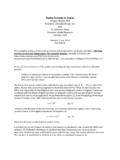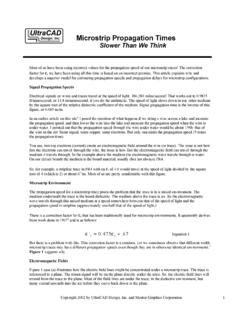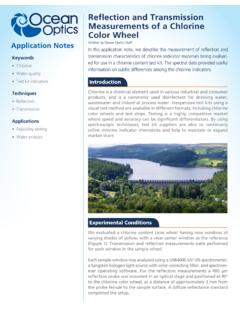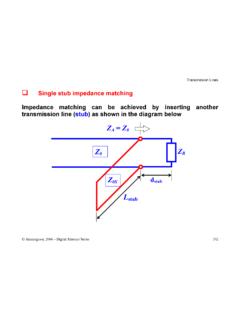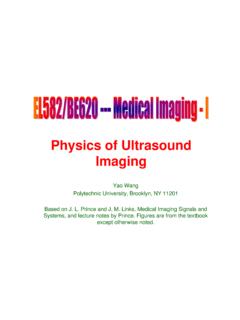Transcription of Propagation Times and Critical Length How They …
1 Propagation Times and Critical Length How they interrelate 1 In a recent article I drew an analogy between signal reflections on electrical traces and echoes in a In each case, the echo or reflection can interfere with the receiver s ability to understand the message being communicated. I suggested that there were five possible solutions to this communication problem. Two of them were (a) slow down the message (use a slower rise time ) or (b) move closer to the speaker (shorten the trace). This suggests that there might be a relationship between trace Length and rise time . That is, for a given rise time , communication problems caused by reflections are worse for longer traces than for shorter traces. Similarly, for a given trace Length , slower rise Times cause fewer communications problems than faster rise Times .
2 And indeed this is true. To look at this relationship, we need first to look at Propagation Times in general. Think about this experiment. Let s string two bare copper wires across a body of water (a small lake or a river). One of the wires is suspended in the air above the water; the other is strung under the water. We ll design this experiment so that the lengths of copper wire are equal. Then we will measure the Propagation time for an electrical signal down the Length of each wire. Our results will show that the Propagation time for the signal along the wire under the water is almost nine Times longer than for the signal along the wire above the water! Electromagnetic waves: Current, by definition, is the flow of electrons. To help us think about our experiment, let s think about the signal consisting of a flow of individual electrons moving along the A change in the signal (for example between a logical 1 and a logical 0) represents a change in the number of electrons passing a single point per unit time .
3 Electrons have a negative charge. Perhaps you recall from school days that like charges repel and unlike charges attract. The electrons moving along the wire repel other electrons that might be nearby. In order to do this, there must be an electrical field radiating from the wire caused by the presence of the electrons. There is, indeed, such a field around a wire carrying current. It radiates outward from the wire and is proportional to the magnitude of the current. A changing current causes a changing electrical field. In addition, when current flows along a wire, a magnetic field is generated around the wire. This is the fundamental principle behind an electrical motor. A changing electrical field generates a changing magnetic field. This is related to the principle behind an electrical generator.
4 These two fields, one electrical (or charge related) and one magnetic, are collectively referred to as the electromagnetic field around a wire. While the current flows within the wire, the electromagnetic field flows in the medium around the wire. It is important to note that the electrons forming the current, the electrical field and the magnetic field all must move together. One can t get out in front of or lag behind either of the other two. We now have the basis for understanding why the signal flowing along the wire under water propagates so much more slowly than along the wire above the water. The limiting factor is Copyright 2002 by UltraCAD Design, Inc. and Mentor Graphics Corporation Propagation Times and Critical Length How they interrelate 2 not the speed with which the electrons can flow along the copper; the limiting factor is how fast the electromagnetic field can propagate through the medium surrounding the wire.
5 Propagation Times : Electrical signals in a vacuum travel at the speed of light, 186,280 miles/second. If you do the units conversion,3 this reduces to in/nsec, or approximately a foot a nanosecond, a rule of thumb perhaps you are familiar with. they travel at almost exactly the same speed in air at the Equator. But signals slow down in any other medium, because the electromagnetic field is slowed down in any other medium. For those of us in the printed circuit design field, the parameter that relates to this change in speed is called the relative dielectric coefficient and is generally represented by the symbol er . Specifically, the Propagation speed of a signal in any homogeneous medium is given by the expression: in/nsec This formula is considered very accurate for traces in stripline environments where the traces are surrounded by a (reasonably) homogeneous medium.
6 For example, FR4 has an er of approximately 4. The square root of 4 is 2. So the Propagation speed of signals along traces in FR4 stripline environments is approximately 6 /nsec. The er for water is approximately 80, depending, of course, on the purity of the water. The square root of this is approximately 9, explaining why the signal along the wire under water travels at one-ninth the speed of the signal traveling along the wire suspended in the air. A trace in a microstrip environment is not surrounded by a homogeneous medium. There might be FR4 underneath the trace and air above the trace, each with different values for er. The general practice in the industry is to use the following formula to approximate the effective value for er for microstrip traces:4 e r =.
7 475er + .67 for 2 < er < 6 Critical Length : Now back to the issue of reflections. It seems intuitive that if a trace is short , reflections will not be much of a problem. That is because the reflection occurs almost coincident with the signal or at the same time the signal is transitioning between levels. Short , in this sense, means that the time it takes for the signal to travel down to the end of the trace and return as a reflection is shorter that the rise time of the signal. A long trace, however, is one in which the signal reflection returns after the message (after the signal transitions from one state to another) and then interferes with the signal level. Long, in this sense, means that the Length of time it takes a signal to travel down a trace and reflect back is significantly longer than the rise time of the signal.
8 Figure 1 illustrates these points. A is a driver driving a signal down a trace. B1 and B2 are receivers. The black curve represents the signal being driven by A. The green and red curves represent the signals as they arrive at B1 and B2, respectively. The curves are approximately scaled. If the rise time of the driven signal is 1 nanosecond, and the Propagation speed is 6 /ns, then the distance from A to B1 is Propagation Times and Critical Length How they interrelate 3 approximately .3 ns ( in.) and the distance from A to B2 is approximately ns ( in.) Consider the point x along the driven signal. It takes .3 ns for that point on the waveform to propagate to B1, and another .3 ns to reflect back to the driver. When the reflection arrives at the driver, the driver is still driving the signal onto the trace, and the reflection has little or no effect on the system.
9 We can think of this in two ways: (1) the driver has inertia as it is driving, so it simply overpowers the reflection, or (2) the reflection has no consequence since no signal sampling is occurring while the driver is still driving. But that same point, x , along the driven signal takes ns to travel to B2, and if it reflects back it takes another ns to return to A ( ns round trip.) This time , when the reflection returns to A the driven signal is at a stable level. Now, the reflection might have a significant effect on system operation. It seems clear from this illustration that the distance between A and B1 is a short distance, and the distance between A and B2 is a long distance. A legitimate question is, What is the boundary between a short and a long trace Length , the point where we need to take transmission line and termination techniques into consideration?
10 It must be noted that this boundary is not a sharp one. The relationship between the impact of reflections and trace Length is really a continuum that simply increases as the trace gets longer. The generally accepted standard for this boundary, often called the Critical Length , is when the Propagation time for the signal to reach the end of the trace and return (the round trip Length ) is equal to the rise time . For a 1 ns signal and a Propagation time of 6 /ns, for example, the round trip distance in 1 ns would be 6 inches. That means the one-way Length to the end of the trace would be half that, or 3 . So the Critical Length in FR4 is often defined as 3 Times the rise time in nanoseconds. Simple Simulation: Figures 2 and 3 are a Signal Vision simulation of the conditions suggested in Figure Figure 2 shows the basic model being simulated and Figure 3 illustrates the results.

